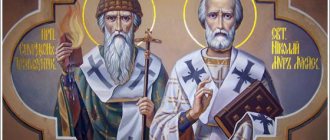People can relate to celestial phenomena in different ways, but among them there is one that has a special mystical meaning for the population of most countries. It is considered the Star of Bethlehem - not only a gift from the cosmos, but also one of the most important Christian symbols of the existence of God.
What is the Star of Bethlehem?
Let's start with history. According to the Gospel of Matthew, the three wise men, having seen a new bright star in the sky in the east (or, more accurately translated, at sunrise), went towards it to worship Jesus Christ. From ancient legends they knew that such a star would lead them to the King of the Jews. The Magi came to Jerusalem, but did not find the Savior there and, on the advice of King Herod, they went to Bethlehem, where the star stopped right above the house of the Holy Family. Having bowed to Jesus and brought him gifts - gold, frankincense and myrrh, they set off on their way back to their homeland to preach the birth of the Savior there. To this day, these three sages are revered as saints, and their relics are located in Cologne.
Choosing a talisman
Metal amulets, moreover, those made of noble metals, have the greatest power. Combination with inserts of precious and semi-precious stones is allowed. Usually the amulet is worn on the neck, like a cross, closer to the heart, so the Star of Erzgamma pendant is the best choice.
Stone inserts can strengthen the talisman and direct its energy in the direction preferred by the owner. They are selected by shade. Below is a table of correspondence between the color of the insert and the issue it will help solve.
However, when purchasing, it is recommended to pay attention not only to the appearance of the product. Since the talisman has magical properties, its energy should suit the owner. You should hold the product in your hands for a while and listen to your feelings: does the amulet cause rejection. If you don’t want to let go of it, and warmth emanates from it, then the choice was made correctly.
Was there a star?
Criticizing the Holy Scriptures, some argued that there was no star, and that this was just a later insertion into the original text, designed to decorate it and make it more solemn.
However, it has already been proven that the events described in the texts by the evangelists practically do not contradict real historical events. Therefore, we can assume that in fact at that time there was actually some kind of cosmic body in the sky. In addition, the style of presentation indicates that the authors told the events exactly as they happened, without inventing additional elements of the story, otherwise the Gospels would look different in terms of consistency. For believers, an angel leading the Magi would perhaps look more natural and logical than some kind of star. Why include it in the text if in fact it did not exist?
The power of the amulet
Compared to other popular amulets, the talisman does not have a clear direction in action. It's universal.
The Star of Erzgamma amulet has the amazing property of giving the owner exactly what he needs at the moment. Moreover, the talisman often knows more about the needs of the owner than he himself.
The amulet can be used for:
- attracting good luck;
- increasing financial well-being;
- health promotion;
- improving family relationships;
- enlightenment, spiritual cleansing;
- protection from the evil eye, damage.
The Star of Ertsgamma is a powerful artifact. Modern symbolists see more in it than the ancients. According to them, the sign of the Star of Erzgamma means not only the apostles and the crucifixion. The shape of the symbol combines four equilateral triangles, symbolizing the esoteric elements: Fire, Air, Water, Earth. If the amulet is made of metal, then this fifth element is also connected to its power. The symmetrical shape symbolizes balance, the interweaving of rays - the combination and interpenetration of elements.
Parade of planets
One of the most likely explanations for this phenomenon is given by astronomers - most likely, it was the so-called parade of planets, when the Earth, Sun, Jupiter and Saturn lined up in one line. It must have looked amazing, and it is not surprising that mystical significance was attributed to such a phenomenon.
It is worth saying that the three wise men heading to the Savior were scientists, mathematicians, astronomers of their time, revered in society. Therefore, studying planets and stars was their profession.
Bright comet
Another version of the origin of the Star of Bethlehem says that it was a comet. Judging by the time of the gospel events, it was most likely a comet from the constellation Capricorn that appeared in the 5th century BC, described in detail by astronomers from China. However, at that time, such cosmic bodies were considered mainly a bad omen, so it is not at all a fact that the appearance of that comet could be interpreted as a blessed sign of the appearance of the Savior.
However, there is another option proposed by modern astronomers. It was this phenomenon that the three wise men could see: a bright star appeared in the 4th century BC in the constellation Eagle and seemed to be located just above Jerusalem. Here is a photo of the Star of Bethlehem.
Where to buy, price
According to reviews, you can purchase the Erzgamma star both in online stores and in jewelry stores. The price of products varies depending on the material and size. Bronze amulets can be found from 250 rubles.
Jewelry encrusted with precious stones can cost up to several thousand dollars.
In addition to pendants and pendants, you can choose earrings, brooches, and badges. The average price of silver stars is 1.5-3 thousand rubles. Gilding within 5-7 thousand. Gold jewelry from 10 thousand rubles. The cost is approximate, depending on the region and the artist.
Red Star
It is worth saying that now this name also includes other, non-astronomical objects. For example, there is a flower called the star of Bethlehem - this is the well-known poinsettia, which many people buy before Christmas (and sometimes before the New Year). It blooms with not very beautiful small yellow flowers, but pleases the eye with leaves - red, green, white, sharply contrasting with each other and creating a festive impression. Its leaves have eight ends, an additional association with the star. Poinsettia is a home plant, beautiful and unpretentious, so it can be found quite often in European homes; in Russia it has not yet become widespread.
Initially, this flower was revered by the Aztecs. After its appearance in Europe around the sixteenth century, a legend associated with the celebration of Christmas arose. According to her, children from poor families really wanted to decorate the temple for the holiday, but they had no money at all for decorations. Therefore, they broke several branches from the bushes growing along the road and brought them to the church, sincerely believing that even with such an offering they would bring the Lord a lot of joy. And when they brought their bouquets into the temple, they were transformed and covered with red and green, star-like leaves. This was the poinsettia.
Since when did Christmas become a holiday in Ukraine?
After the October Revolution of 1917, a complete ban was imposed on the holiday. Evangelical Christians had to hold services at 6 a.m. in order to both have time to go to church and not be late for work.
The Nativity of Christ according to the Julian calendar (January 7) was recognized at the legislative level in the dying USSR only at the end of 1990. In independent Ukraine, on January 7, 1991, Christmas was declared an official holiday and a non-working day.
CCTV News
And on November 16, 2022, the Verkhovna Rada of Ukraine voted for a non-working day on December 25 - Christmas according to the Gregorian calendar, which has been followed by the whole of Europe for centuries.
What does a star look like?
Most often, the Star of Bethlehem is depicted as eight-pointed. People try not to wear it as a body decoration, such as a pendant, because it is considered blasphemous. However, images of the Star of Bethlehem still exist: for example, a silver star is depicted on the floor of a well in the cave where, according to one version, Jesus Christ was born. This place is also called the Sacred Den. Legend has it that the Star of Bethlehem fell there after leading the Magi to the Infant of God. Christians often claim that if you look carefully into the depths of a well lined with silver plates from the inside, you can see the flickering of a celestial body located deep at the bottom. Over the place where, according to this legend, the star is now located, a church was built in the eighteenth century by the monks of the Order of St. Francis of Assisi.
By the way, it was precisely such a star, and not crosses, as now, that was installed on the top of the domes of the very first Orthodox churches.
The eight-pointed star is often used in Christian holidays; such Christmas tree decorations are especially widespread. In Russia, the tradition was changed, and the star became five-pointed. But after the collapse of the Soviet Union, it again had eight ends, and now both traditions exist equally. However, on the main Christmas tree of Russia in the Kremlin there is an authentic star.
Orthodox stores sometimes offer the symbol of the Star of Bethlehem, most often in the form of a gold or silver pendant, costing from three to four thousand rubles. Similar items can now be found in esoteric shops - they offer a variety of jewelry made from a wide variety of metals, most often inexpensive. Of course, it is a rather controversial issue whether people have the right to wear and make such jewelry. Even the opinions of priests on this matter differ radically: for example, some believe that in fact the Star of Bethlehem was lit at one time by Satan to lead King Herod to the Infant God. Therefore, they do not approve of the star symbol itself. Some Orthodox priests consider the eight-pointed star a sign of belonging to Islam. The priests are more unanimous in relation to the five-pointed star, the pentagram, which is considered by church representatives to be a sign of involvement in the worshipers of Satan. The six-pointed Star of David is a clear symbol of Judaism, although followers of this religion wear it very rarely.
The Star of Bethlehem is often used as part of other Christian symbols - for example, in the center of crosses. Often, precious or semi-precious stones are placed in the center of the star.
On almost all icons dedicated to the Mother of God, you can also find the star sign. Since the Mother of God is considered the patron saint of Russia, the Star of Bethlehem is sometimes called Russian. The symbol itself could also mean Heavenly Jerusalem, paradise, perseverance in life situations, or something unearthly, sublime. The star is also associated with the so-called Eighth Day of Creation. It is believed that after the Fall, the Seventh Day continues to this day, after it the Apocalypse will come, and after the Second Coming, eternal life, the eternal Eighth Day, awaits all those saved. Thus, the star has another very important meaning - it symbolizes eternity.
Different peoples, different symbols
As a picture of time, a calendar, a figure with 8 rays was depicted in ancient times; this sign is found in the Latvian cult religion and among the Udmurts.
Finns and Karelians depicted this sign in the form of a cross with forked ends. It is a symbol of guidance and rebirth, the triumph of light over darkness. Perhaps it is for this reason that Great Britain and the Philippines have eight-pointed symbols on their flags.
The Egyptians saw a star with eight rays as a divine sign, symbolizing seven stages in the development of society, after which the eighth would come, the last one - eternal life, and for Christians this is the coming of Jesus Christ.
The eight-pointed symbol meant the birth of the Messiah
In the period from the 14th to the 16th centuries, for Russian icon painting and Orthodox symbolism it was a sign of God the Father, Sabaoth. His images can be found not only on the holy faces of the Mother of God, and on the icons of saints, where he replaced halos.
The Holy Fathers of the 19th century attributed this symbol to heretical signs, for in Egypt the goddesses Isis, Seshat, Maat were depicted under this figure. The ruler of the number eight was the god Thoth.
Astrologers associate the figure with eight rays with Sirius, which has seven ends and a tail. In their opinion, the rainbow is a symbol of the number eight. Its seven colors are transformed from the eighth - white, which is obtained by mixing all seven.
This figure is used by fortune tellers in Tarot cards.
Other meaning
Of course, the main sphere of existence of this sign is Christianity, but the esotericism that is so popular today also uses the Star of Bethlehem.
The meaning of this symbol in magic is an image of the law of karma of a whole kind. It is believed that the seven generations that lived on Earth before the birth of a particular person on it will influence him, and he, in turn, will influence the seven subsequent generations with his thoughts and actions. This theory exists because there were fourteen generations between Jesus Christ and his ancestor, King David of Judah. Many star pendants are created under the influence of this particular esoteric trend.
Why does Christmas fall on both December 25 and January 7?
In the 4th century, when the Catholic Church recognized Christmas as an official holiday, on the initiative of Pope Julius I, December 25 was chosen as the date of the Nativity of Christ. This date coincides with the pagan holiday - Saturnalia. Some historians argue that the church fathers did not choose December 25 by chance. Because they believed that Jesus Christ was born during the winter solstice, on the shortest day on earth.
St. Augustine argued that the birth of Christ symbolizes the rising of the sun described in Malachi 4:2.
The first celebration of the Nativity of Christ took place on December 25, 354 AD. This day coincided with the peak of the celebration of the Birthday of the Invincible Sun, which, with the light hand of Emperor Aurelian, was recognized as the supreme god of the Roman Empire.
Christmas, nativity sceneDepositphotos
Initially, Christmas was celebrated on December 25 by all Christian churches, but in 1582, Pope Gregory XIII approved a new calendar. But the Orthodox Church in Moscow abandoned the innovation and continued to live according to the Julian calendar. And in 1918, with the Bolsheviks coming to power, the Gregorian calendar (the so-called “new style”) was introduced. The church, meanwhile, continued to use the old Julian calendar, and so Christmas moved by 2 weeks.
By the way, according to calculations, by 2800 there will be a complete coincidence in the dates of the old and new calendars. In the meantime, the Gregorian (New Julian) lags behind by about 5 days (although in the Orthodox calendars the difference between the old and new styles is 13 days in a non-leap year).











